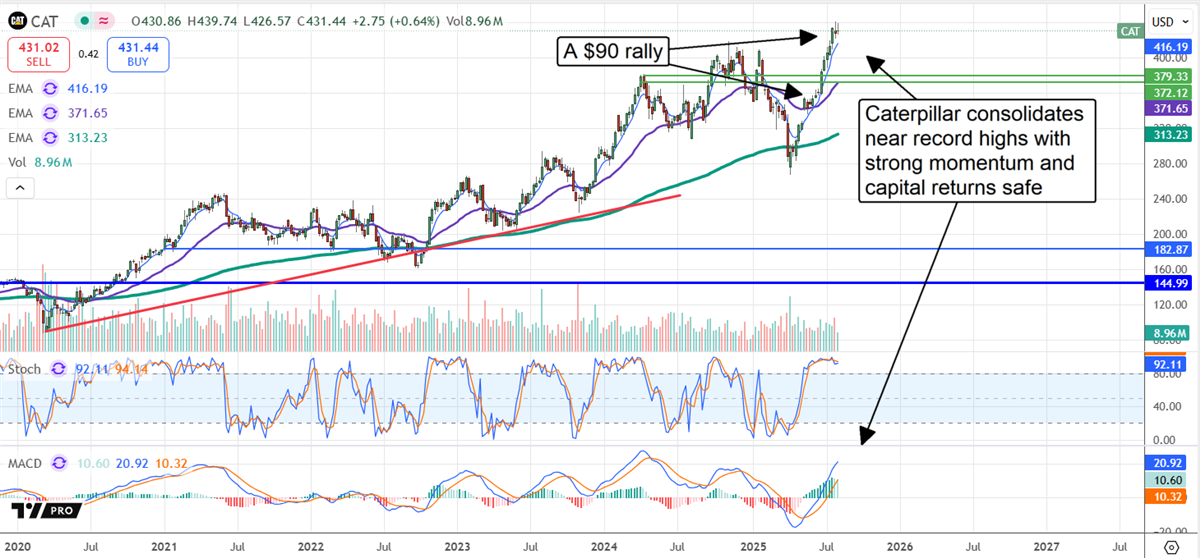Caterpillar (NYSE:) faces headwinds like any multinational business today, but its Q2 results highlight why its stock price can, and will, crawl higher over time. While macroeconomic headwinds, including lower realized prices, cut into revenue and earnings, the business is on the cusp of returning to growth, and its capital return is safe.
The capital return is critical for Caterpillar investors and includes dividends, distribution growth, and share buybacks.
The dividend alone is solid. The stock yields about 1.4% while trading near the early August highs, and it is a safe and reliable payment. Caterpillar is a Dividend Aristocrat with a payout ratio below 30%, a level suggesting sustainable annual increases can continue for years and may accelerate in size with growth back on the table.
The company is increasing at a moderate single-digit CAGR in 2025, more than sufficient to offset the impact of inflation. And the share buybacks are more substantial.
The buybacks are aggressive and expected to continue aggressively into the future. Buyback activity reduced the count by 3.6% year-over-year (YOY) on average for the quarter and will likely continue robustly because of the cash flow and balance sheet health.
The total capital return was less than 50% of cash flow in Q2, leaving the balance sheet in a healthy condition. Quarter-end highlights include a slight reduction in cash, an increase in liability, and a reduction in equity.
Still, they are offset by increased assets, low leverage, and the increase in treasury stock or reacquired shares. Treasury stock increased by more than 4x the reduction in equity.
Caterpillar Struggles With Headwinds: Guides for Growth
Caterpillar had a tough time in Q2 with realized pricing more than offsetting the increased volume. However, the increased volume sustains a healthy business and outlook that includes the resumption of revenue growth.
Until then, the $16.6 billion net revenue was down only 1% compared to the prior year, with significant sequential growth reported in all major segments. Segmentally, construction was the weakest with a 7.5% decline compared to last year, while Energy was the strongest at +7%.
Regionally, emerging markets were the strongest, growing by 6% year over year, while North America, Latin America, and Asia all posted low single-digit contractions.
The margin news is a sticking point for the market that could limit stock price gains in calendar Q3. The company reported a wider-than-expected decline in operating results due to tariff impacts and price realization, leaving the $4.72 adjusted EPS well below MarketBeat’s reported consensus.
However, as mentioned, the earnings and cash flow are sufficient to sustain the company’s financial health, growth outlook, and capital return, and the guidance is favorable. The company is forecasting revenue to be “slightly higher” than the previous year, which is an improvement from the prior guidance.
Analysts and Institutional Trends Provide Support for Caterpillar Stock
The analysts’ trends suggest significant support for this industrial stock, including increased coverage, upgrades, and price target increases that lead to the high-end range. The net result is an increase in sentiment from last year’s Hold to this year’s Moderate Buy and an expectation for higher share prices.
The high-end range puts this market near $500 or another 20% increase from the early August trading levels.
The stock price action was mixed following the release, with selling offset by buying. The takeaway is that Caterpillar stock is consolidating near record highs and may extend its rally later this year.
 In that scenario, it could easily level rise to the $500, potentially topping out near $520 sometime in 2026.
In that scenario, it could easily level rise to the $500, potentially topping out near $520 sometime in 2026.